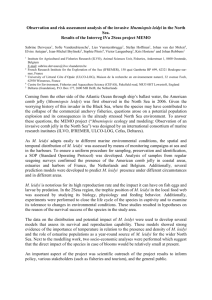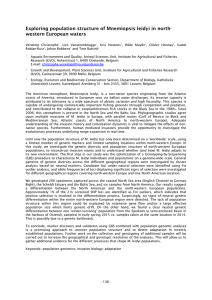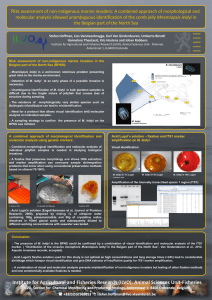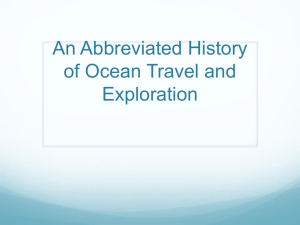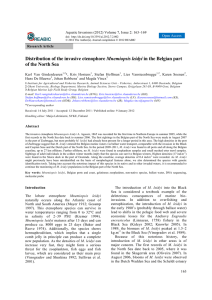Aquatic Invasions (2009) Volume 4, Issue 4: 675-680
advertisement
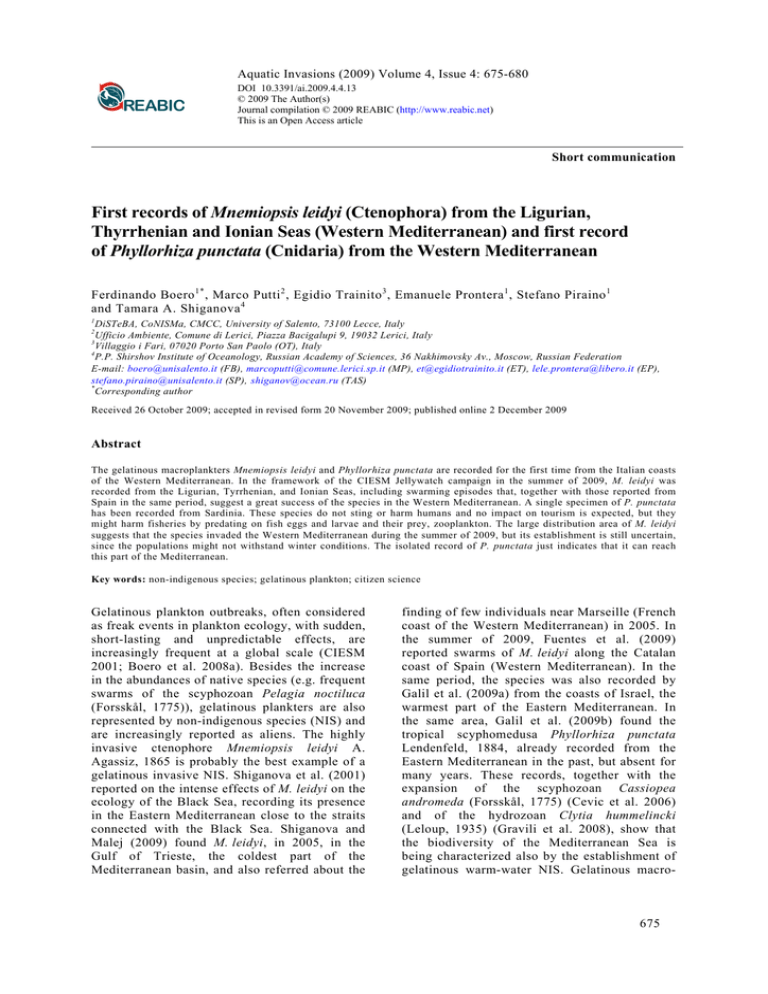
Aquatic Invasions (2009) Volume 4, Issue 4: 675-680 DOI 10.3391/ai.2009.4.4.13 © 2009 The Author(s) Journal compilation © 2009 REABIC (http://www.reabic.net) This is an Open Access article Short communication First records of Mnemiopsis leidyi (Ctenophora) from the Ligurian, Thyrrhenian and Ionian Seas (Western Mediterranean) and first record of Phyllorhiza punctata (Cnidaria) from the Western Mediterranean Ferdinando Boero 1* , Marco Putti 2 , Egidio Trainito 3 , Emanuele Prontera 1 , Stefano Piraino 1 and Tamara A. Shiganova 4 1 DiSTeBA, CoNISMa, CMCC, University of Salento, 73100 Lecce, Italy Ufficio Ambiente, Comune di Lerici, Piazza Bacigalupi 9, 19032 Lerici, Italy 3 Villaggio i Fari, 07020 Porto San Paolo (OT), Italy 4 P.P. Shirshov Institute of Oceanology, Russian Academy of Sciences, 36 Nakhimovsky Av., Moscow, Russian Federation E-mail: boero@unisalento.it (FB), marcoputti@comune.lerici.sp.it (MP), et@egidiotrainito.it (ET), lele.prontera@libero.it (EP), stefano.piraino@unisalento.it (SP), shiganov@ocean.ru (TAS) * Corresponding author 2 Received 26 October 2009; accepted in revised form 20 November 2009; published online 2 December 2009 Abstract The gelatinous macroplankters Mnemiopsis leidyi and Phyllorhiza punctata are recorded for the first time from the Italian coasts of the Western Mediterranean. In the framework of the CIESM Jellywatch campaign in the summer of 2009, M. leidyi was recorded from the Ligurian, Tyrrhenian, and Ionian Seas, including swarming episodes that, together with those reported from Spain in the same period, suggest a great success of the species in the Western Mediterranean. A single specimen of P. punctata has been recorded from Sardinia. These species do not sting or harm humans and no impact on tourism is expected, but they might harm fisheries by predating on fish eggs and larvae and their prey, zooplankton. The large distribution area of M. leidyi suggests that the species invaded the Western Mediterranean during the summer of 2009, but its establishment is still uncertain, since the populations might not withstand winter conditions. The isolated record of P. punctata just indicates that it can reach this part of the Mediterranean. Key words: non-indigenous species; gelatinous plankton; citizen science Gelatinous plankton outbreaks, often considered as freak events in plankton ecology, with sudden, short-lasting and unpredictable effects, are increasingly frequent at a global scale (CIESM 2001; Boero et al. 2008a). Besides the increase in the abundances of native species (e.g. frequent swarms of the scyphozoan Pelagia noctiluca (Forsskål, 1775)), gelatinous plankters are also represented by non-indigenous species (NIS) and are increasingly reported as aliens. The highly invasive ctenophore Mnemiopsis leidyi A. Agassiz, 1865 is probably the best example of a gelatinous invasive NIS. Shiganova et al. (2001) reported on the intense effects of M. leidyi on the ecology of the Black Sea, recording its presence in the Eastern Mediterranean close to the straits connected with the Black Sea. Shiganova and Malej (2009) found M. leidyi, in 2005, in the Gulf of Trieste, the coldest part of the Mediterranean basin, and also referred about the finding of few individuals near Marseille (French coast of the Western Mediterranean) in 2005. In the summer of 2009, Fuentes et al. (2009) reported swarms of M. leidyi along the Catalan coast of Spain (Western Mediterranean). In the same period, the species was also recorded by Galil et al. (2009a) from the coasts of Israel, the warmest part of the Eastern Mediterranean. In the same area, Galil et al. (2009b) found the tropical scyphomedusa Phyllorhiza punctata Lendenfeld, 1884, already recorded from the Eastern Mediterranean in the past, but absent for many years. These records, together with the expansion of the scyphozoan Cassiopea andromeda (Forsskål, 1775) (Cevic et al. 2006) and of the hydrozoan Clytia hummelincki (Leloup, 1935) (Gravili et al. 2008), show that the biodiversity of the Mediterranean Sea is being characterized also by the establishment of gelatinous warm-water NIS. Gelatinous macro- 675 F. Boero et al. plankters, albeit very evident to casual observers, are rarely reported in traditional plankton studies since, when abundant, they clog plankton nets, and are not observed from satellites. As a consequence, both the traditional (nets) and the modern (satellites) ways to study plankton frequently underestimate gelatinous plankters. Blue diving and submersibles are the preferred methods to study their presence (Mills 1995), but do nonetheless require intense observation efforts that make large scale evaluations difficult. In spite of repeated claims that our oceans are shifting from fish to jellyfish (see Mills 1995; Boero et al. 2008a for reviews), records of gelatinous swarms are usually scattered and the perceived global trend derives more from the collation of disconnected records rather than from a coordinated, large scale appreciation of the phenomenon. When the ctenophore Mnemiopsis leyidi suddenly appeared in the Black Sea, developed enormous populations and affected the total ecosystem and fish stocks, the evidence of the importance of gelatinous plankton in marine ecology became overwhelming. From the Black Sea, the invasive ctenophore spread to the Sea of Azov, Marmara and the Aegean Sea. It was also brought into the Caspian Sea, where it strongly affected all ecosystems, with the exception of the Aegean Sea, where it did not create a reproductive population due to oligotrophic conditions (Shiganova 1993; Shiganova et al. 2001, 2004). To acquire a more precise picture of the occurrence of gelatinous plankton aggregations, the Mediterranean Commission (CIESM), launched a citizen science initiative, the Jellywatch Programme, in the summer of 2009. Citizen science is becoming a common practice, especially to record the presence of species that are not easily recorded by traditional methods (Silvertown 2009), such as gelatinous plankters. The pilot phase took place in Italian waters. A poster with the main gelatinous plankters of the Mediterranean Sea was distributed nationwide (Figure 1) with great media coverage helped by the environmentalist association “Marevivo” (http://www.marevivo.it). The 8000 km of the Italian coastline are intensively frequented by tourists throughout the summer and these citizens, together with beach authorities and the Coast Guard, provided hundreds of records of gelatinous plankters. Records were often documented by pictures and were assembled in a database. All the species present in the poster 676 Figure 1. The Poster of the CIESM Jellywatch Campaign (Art by Alberto Gennari, Graphics by Fabio Tresca, Map by Giuseppe Guarnieri) (Translated from the Italian version used during the campaign) were reported, with the exception of Rhopilema nomadica (Galil, 1990),which so far has only been reported in the Eastern Mediterranean basin. Records of Mnemiopsis leidyi. The first records of M. leidyi were made offshore, from boats in the Ligurian Sea, in May 2009, but no pictures were provided. Being the first known records of the species in this part of the Western Mediterranean, these observations were considered as dubious due to lack of proper documentation. In June 2009, a swarm of M. leidyi in the Ligurian Eastern Riviera was photographed repeatedly. The organisms (Figures 2A, B) were clearly identifiable as M. leidyi. The species was present in that area continuously throughout the summer, until its decline. When the swarms started to dissolve, numerous specimens of the fish Sarpa salpa (L., 1758) were seen to feed upon the spent ctenophores (Figure 2C). The complete list of Mnemiopsis leidyi and Phylloriza punctata in W. Mediterranean Figure 3. Map of the Italian coast with all locations where Mnemiopsis leidyi was recorded (red dots) during the summer of 2009 (for details see Table 1). Phyllorhiza punctata wasrecorded from Tavolara Island (yellow dot) Figure 2. A swarm of Mnemiopsis leidyi from the Ligurian Sea (A), M. leidyi from the same locality (B), fish (Sarpa salpa) prey upon spent M. leidyi (C) (Photos by Marco Putti) sightings (occasionally backed up by photographs) is reported in Table 1 (see also Figure 3). Record of Phyllorhiza punctata. A specimen of P. punctata was photographed at the sea surface inside the Marine Protected Area of Tavolara, at Cala Suaraccia, Sardinia on October 1st 2009 (Figures 3, 4). The jellyfish umbrella measured 35 cm in diameter. It was not collected. This is the first record of this species from Italian waters and from the Western Mediterranean. Figure 4. Phyllorhiza punctata. Photographed from the surface at Tavolara Island, Sardinia (Photo by A. Severino) 677 F. Boero et al. Table 1. Records of Mnemiopsis leidyi along the Italian coasts during the summer 2009, deriving from the CIESM Jellywatch Geographic coordinates Latitude, N Longitude, E Survey date (in 2009) offshore Genova 44°20'01.25" 8°54'23.95" May 03 offshore Genova 43°41'29.38" 8°58'34.04" June18-19 Fiascherino, Lerici 44°03'25.00" 44°03'44.12" 9°55'54.88" 9°55'23.64" May 20 July 29 Recco 44°21'21.96" 9°08'30.65" Marinella di San Terenzo 44°04'56.60" 44°04'56.60" 44°04'53.14" 44°04'53.14" Ponza island Tellaro, Lerici Estimated abundance Photo 3 specimens No scattered specimens No <10 specimens patches of 10-20 specimens Yes Yes June 26 5 specimens No 9°53'40.43" 9°53'40.43" 9°53'25.82" 9°53'25.82" July 05 July 28 July 31 Sept 01 thousands thousands >10 specimens >10 specimens Yes Yes Yes Yes 40°53'37.69" 12°58'02.29" July 13 thick patches No 44°03'29.94" 9°55'42.76" July 27 thousands Yes Eolie islands 38°29'33.85" 14°54'26.71" Aug 01 1 specimen No Nervi 44°22'50.46" 9°01'49.79" Aug 01 2 specimens No Punta Falcone, Piombino 42°55'54.91" 10°29'47.61" Aug 01 6 specimens No Baia Blu La Spezia 44°04'58.47" 9°53'12.80" Aug 02 thick patches No Petrosino 37°42'32.00" 12°30'04.02" Aug 06 scattered specimens No Quercianella 43°27'33.50" 10°22'09.43" Aug 22 patches No Rocchette 42°42'58.00" 10°57'38.26" Aug 23 patches No Isola di capo Rizzuto 38°54'33.26" 17°01'26.67" Sept 06 1 specimen No Location Talamone 42°33'22.67" 11°07'17.67" Sept 08 <10 specimens Yes Formiche di Grosseto 42°34'60.00" 10°52'60.00" Antignano 43°25'36.42" 10°19'17.45" Argentario 42°26'20.38" 11°07'26.13" Calafuria 43°28'21.54" 10°20'25.74" Sept 09 Sept 09 Sept 10 Sept 10 Sept 13 Oct 04 <10 specimens 1 specimen 1 specimen <10 specimens patches of 10-20 specimens 2 specimens Yes No No Yes No No Citizen science is an effective tool for monitoring gelatinous macroplankton. Many observations reported here, in fact, were not made by professional scientists, but stem from lay individuals that were aware of the Jellywatch campaign and made their reports accordingly. The CIESM Jellywatch, furthermore, increased attention towards gelatinous plankton, so leading to records of species that were not even covered by the campaign, such as P. punctata. The distribution of professional researchers along the thousands of km of the Mediterranean coast is insufficient to effect a proper coverage of the entire area, whereas lay persons can provide information that otherwise would be lost. Scientific surveys, entailing the employment of scientists and oceanographic vessels, would be expensive and inefficient, considering the erratic occurrence of gelatinous plankton. 678 The records from the Catalan coast (Fuentes et al. 2009), coupled with the present ones, demonstrate that, during the summer 2009, M. leidyi was present along the northwestern coast of the Mediterranean. It is improbable, as suggested also by Fuentes et al. (2009), that the species reached all these places through human intervention, e.g. by transport in ballast tanks. The spread of the species outside the Black Sea, (Shiganova et al. 2001; Galil et al. 2009a) and the present records, show that M. leidyi is present throughout the Mediterranean, from the coldest (Gulf of Trieste, Italy) to the warmest (Israel) areas of the basin. Experimental data have shown that the conditions of the Aegean Sea can be well tolerated by M. leidyi. It can live, feed at a high intensity, and reproduce there. Its eggs develop well, with high percent survival and development (99.7%). The only Mnemiopsis leidyi and Phylloriza punctata in W. Mediterranean factor which limited creation of semireproductive population was very low prey (zooplankton) density under the oligotrophic conditions of the Aegean Sea (Shiganova et al. 2004). The present outbreaks of Mnemiopsis at several locations of the eastern and western Mediterranean might be the result of changes in the conditions of these coastal areas. This hypothesis is supported by increasing blooms of native jellyfish species, probably favoured by the release of jellyfish from fish predation and or competition due to overfishing (Boero et al. 2008a). It is unclear whether the Western Mediterranean population will survive yearround, but its bloom, as well as the presence of P. punctata, are causes of great concern for the state of Mediterranean ecosystems. Mnemiopsis leidyi formed swarms in the Western Mediterranean (Figure 2A) during the summer but, at the end of the favorable season, the species was preyed upon by fish like Sarpa salpa (Figure 2C). Predation by fish, however, occurred only in the final phase of the blooms, when the individuals were spent. The record of P. punctata, albeit isolated, suggests that the conditions of the Mediterranean Sea are more and more conducive to the spread of species of warm water affinity. The records by Galil et al. (2009b) demonstrate that the species is present in substantial numbers in the Levantine Basin. The present record shows it can spread to the Western Mediterranean. Lotan et al. (1994) suggested that the tropical R. nomadica, highly invasive in the Levantine Basin, will not reach the western Mediterranean due to intolerance of lower temperatures. In spite of having been covered by the Jellywatch poster (Figure 1), R. nomadica was not recorded in the present study; despite a high presence in the Levantine basin, it has not yet been recorded in the western basin, even though climate warming might be conducive to future westward expansions of such warm-water NIS (see Boero et al. 2008b for a review). Mnemiopsis leidyi and P. punctata have severely impacted fisheries in the Black Sea (CIESM 2001) and in the Gulf of Mexico (Johnson et al. 2005) respectively. Not being stingers, however, they should have no negative impacts on tourism and human health. The connection between the presence of gelatinous macroplanktonic NIS and a decrease in fisheries yields is difficult to quantify. The impact of gelatinous plankton on fish recruitment has long been documented and has been highlighted by jellyfish scientists (e.g. Purcell 1989; Mills 1995; Shiganova and Bulgakova 2000; CIESM 2001; Boero and Bonsdorff 2007; Boero et al. 2008a), but only very recently have fisheries scientists begun to introduce it in ecosystem models (Coll et al. 2008; Pauly et al. 2009). This recent conversion, also linked to the enforcement of the ecosystem approach to fisheries (Boero 2009), justifies the call for jellyfish inclusion in future fisheries models. Acknowledgements The Mediterranean Commission (Commission Internationale pour l’Exploration Scientifique de la Mer Méditerranée: CIESM) provided precious advice, support, and resources to produce the poster of the Jellywatch. The Environmentalist Association Marevivo helped in spreading the information about the Jellywatch and collected records from its associates. This work is part of the activities of F. Boero, S. Piraino and T. Shiganova within the EU projects SESAME and MarBEF, and the Italy-Israel Cooperation Programme on Environment Research and Development, funded by Italian Ministry of Environment and Territory. CoNISMa and CMCC provided infra-structure and support. Maps were based on Google Earth. Andrea Gerli, Leonardo Martini, Michele Isman, Giulia Bernardi, Paolo Maria Politi, Elisiana Cozzani, Maria Angela Bari, Salvio Foglia, Camille Marquand provided records of M. leidyi. Andrea Severino photo-graphed P. punctata. Bella Galil helped in reviewing the manuscript. References Boero F (2009) Recent innovations in marine biology. Marine Ecology-An Evolutionary Perspective 30 (suppl. 1): 1-12, doi:10.1111/j.1439-0485.2009.00308.x Boero F, Bonsdorff E (2007) A conceptual framework for marine biodiversity and ecosystem functioning. Marine Ecology-An Evolutionary Perspective 28 (Suppl. 1): 134-145, doi:10.1111/j.1439-0485.2007.00171.x Boero F, Bouillon J, Gravili C, Miglietta MP, Parsons T, Piraino S (2008a) Gelatinous plankton: irregularities rule the world (sometimes). Marine Ecology Progress Series 356: 299-310, doi:10.3354/meps07368 Boero F, Féral JP, Azzurro E, Cardin V, Riedel B, Despalatović M, Munda I, Moschella P, Zaouali J, Fonda Umani S, Theocharis A, Wiltshire K, Briand F (2008b) I - Executive Summary of CIESM Workshop Climate warming and related changes in Mediterranean marine biota. CIESM Workshop Monographs 35: 5-21 Çevic C, Erkol IL, Toklu B (2006) A new record of an alien jellyfish from the levantine coast of Turkey - Cassiopea andromeda (Forsskal, 1775) (Cnidaria: Scyphozoa: Rhizostomea). Aquatic Invasions 1: 196-197, doi:10.3391/ai.2006.1.3.18 679 F. Boero et al. CIESM (2001) Gelatinous plankton outbreaks: theory and practice. CIESM workshop Series 14, 112 pp Coll M, Lotze HK, Romanuk TN (2008) Structural degradation in Mediterranean Sea food webs: testing ecological hypotheses using stochastic and mass-balance modelling. Ecosystems 11: 939-960, doi:10.1007/s10021008-9171-y Fuentes VL, Atienza D, Gili J-M, Purcell JE (2009) First record of Mnemiopsis leidyi A. Agassiz 1865 off the NW Mediterranean coast of Spain. Aquatic Invasions 4: 671674, doi:10.3391/ai.2009.4.4.12 Galil B, Kress N, Shiganova T (2009a) First record of Mnemiopsis leidyi A. Agassiz, 1865 (Ctenophora; Lobata; Mnemiidae) off the Mediterranean coast of Israel. Aquatic Invasions 4: 356-362, doi:10.3391/ai.2009.4.2.8 Galil BS, Shoval L, Goren M (2009b) Phyllorhiza punctata von Lendenfeld, 1884 (Scyphozoa: Rhizostomeae: Mastigiidae) reappeared off the Mediterranean coast of Israel. Aquatic Invasions 4: 481-483, doi:10.3391/ai.2009. 4.3.6 Gravili C, D’Ambrosio P, Di Camillo C, Renna G, Bouillon J, Boero F (2008) Clytia hummelincki (Hydroidomedusae, Leptomedusae) in the Mediterranean Sea. Journal of the Marine Biological Association of the United Kingdom 88 (8): 1547-1553, doi:10.1017/S0025315408001975 Johnson DR, Perry HM, Graham WM (2005) Using nowcast model currents to explore transport of non-indigenous jellyfish in the Gulf of Mexico. Marine Ecology Progress Series 305: 139-146, doi:10.3354/meps305139 Lotan A, Fine M, Ben-Hillel R (1992) Synchronization of the life cycle and dispersal pattern of the tropical invader scyphomedusan Rhopilema nomadica is temperature dependent. Marine Ecology Progress Series 109: 59-65, doi:10.3354/meps109059 Mills CE (1995) Medusae, siphonophores, and ctenophores as planktivorous predators in changing global ecosystems. ICES Journal of Marine Science 52 (3-4): 575-581, doi:10.1016/1054-3139(95)80072-7 680 Pauly D, Graham W, Libralato S, Morissette L, Palomares MLD (2009) Jellyfish in ecosystems, online databases, and ecosystem models. Hydrobiologia 616: 67-85, doi:10.1007/s10750-008-9583-x Purcell JE (1989) Predation of fish larvae and eggs by the hydromedusa Aequorea victoria at a herring spawning ground in British Columbia. Canadian Journal of Fisheries and Aquatic Sciences 46: 1415-1427, doi:10.1139/f89-181 Shiganova TA (1993) Ctenophore M. leidyi and ichthyoplankton in the Sea of Marmara in October of 1992. Oceanology 33: 900-903 Shiganova TA, Bulgakova YV (2000) Effect of gelatinous plankton on the Black and Azov Sea fish and their food resources. ICES Journal of Marine Science 57: 641-648, doi:10.1006/jmsc.2000.0736 Shiganova TA, Mirzoyan ZA, Studenikina EA, Volovik SP, Siokou-Frangou I, Zervoudaki S, Christou ED, Skirta AY, Dumont HJ (2001) Population development of the invader ctenophore Mnemiopsis leidyi, in the Black Sea and in other seas of the Mediterranean basin. Marine Biology 139 (3): 431-445, doi:10.1007/s002270100554 Shiganova T, Christou ED, Bulgakova JV, Siokou-Frangou I, Zervoudaki S, Siapatis A (2004) Study on the distribution and biology of the invader M. leidyi in the northern Aegean Sea, comparison with indigenous species Bolinopsis vitrea. In: Dumont H, Shiganova T and Niermann U (eds), The Ctenophore Mnemiopsis leidyi in the Black, Caspian and Mediterranean Seas and other aquatic invasions. NATO Science Series: IV: Earth and Environmental Sciences, Springer Netherlands, pp 113-135, doi:10.1007/1-4020-2152-6_4 Shiganova TA, Malej A (2009) Native and non-native ctenophores in the Gulf of Trieste, northern Adriatic Sea. Journal of Plankton Research 31 (1): 61-71, doi:10.1093/ plankt/fbn102 Silvertown J (2009) A new dawn for citizen science. Trends in Ecology and Evolution 24 (9): 467-471, doi:10.1016/ j.tree.2009.03.017
